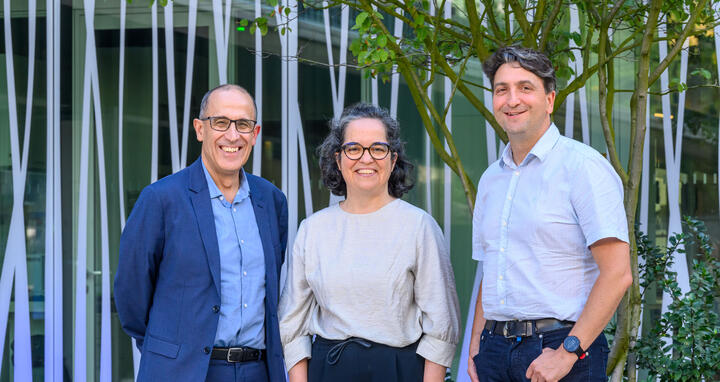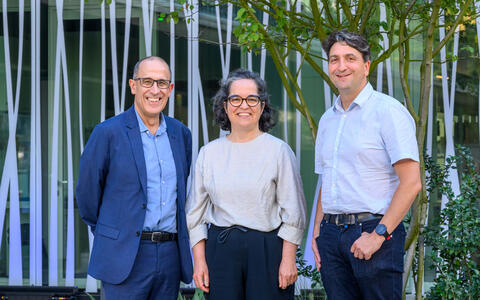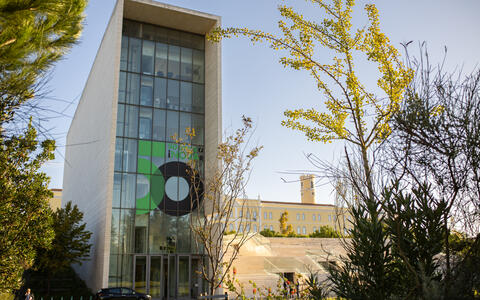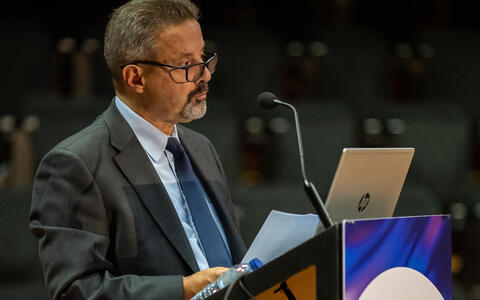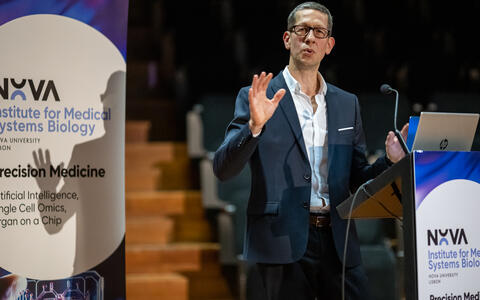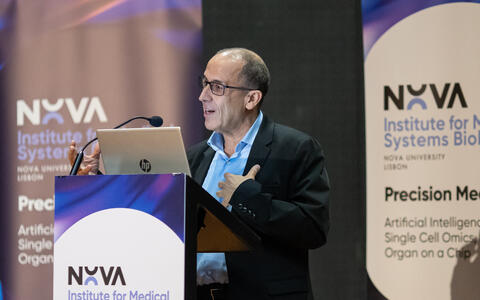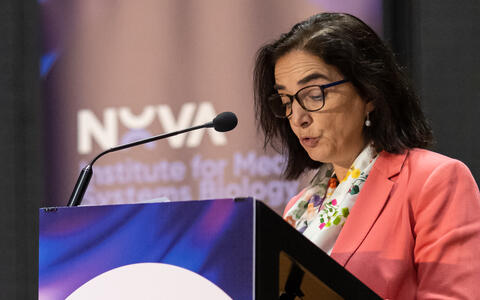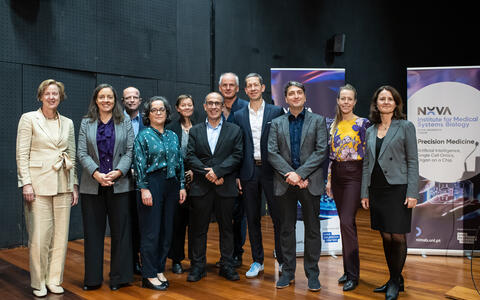From Berlin to Lisbon and back
Throughout its life, a cell repeatedly draws on the instructions contained in its genome. It reads them like a handbook, learning how to respond to external influences. Using patient-derived organoids, single-cell biology methods, and AI, researchers can observe them in the process. They want to understand when and why a cell changes in the direction of disease, and how cells can be guided back to a healthy state. If a diagnosis can be made before consequential damages occur and the disease can be stopped in its tracks, patients could be spared a great deal of suffering.
It's no coincidence if this concept sounds familiar: NIMSB is modeled after the Berlin Institute for Medical Systems Biology at the Max Delbrück Center (MDC-BIMSB). “We are thrilled about this strategic partnership. Collaboration is key to realize our ideas,” says Professor Ana Pombo, MDC-BIMSB Deputy Scientific Director, who is heading the project together with Dr. Stan Gorski, scientific strategy manager at MDC-BIMSB, and Professor António Jacinto from NOVA University. The European Commission has granted 15 million euros in funding to establish NIMSB as a Center of Excellence; NOVA University has secured an additional 20 million euros from Portugal.
- About the NOVA Institute for Medical Systems Biology (NIMSB)
A major barrier to the early diagnosis of chronic diseases as well as selecting the most effective therapy for an individual patient is our insufficient understanding of these diseases at the cellular level. NIMSB aims to pioneer interdisciplinary research to detect the earliest cellular changes, translate this knowledge into novel diagnostics – and steer the cells back to a healthy path before irreparable damage to tissues and organs can even occur. This is made possible by integrating technologies such as single-cell and spatial multi-omics, artificial intelligence, and patient-derived disease models (organoids and organ-on-a-chip).
We need to understand and define when, why, and how cells deviate from healthy states in specific patient groups, based on their genetic background and environmental history. Health research in diverse human populations is key for more inclusive and precise treatments within Europe and worldwide.
NIMSB is a partnership between the NOVA University Lisbon, Portugal, and the Max Delbrück Center in Berlin, Germany. It is supported by the European Union (“Teaming for Excellence” grant – Horizon Europe, € 12,006,000 for NOVA, € 2,986,000 for Max Delbrück Center), the Portuguese Government and the Municipality of Oeiras, Portugal.
How did all of this start? How do you know each other?
António Jacinto: NOVA University Lisbon had decided to develop a focus on precision medicine and I was part of a working group developing a concept. When I read the perspective in “Nature” on the LifeTime initiative, I realized: This is it! Systems biology applied to medicine, taking advantage of these new technologies! At the same time, there was an opportunity in the Horizon Europe program to apply for initial funding to create tandems – to establish a new center of excellence in collaboration with leading research centers in Europe. When I started looking for partners, I saw that a former colleague, Ana Pombo, was part of LifeTime and got in touch with her.
Ana Pombo: We realized that this is completely in line with all our strategies! There was a tight deadline to the first application round, but there was immediate support by the directorate and the faculty of the Max Delbrück Center to support the development of the concept. That summer is a blur; we worked hard, but all doors were open.
Stan Gorski: Creating the NIMSB is a very concrete opportunity to implement the vision developed by the pan-European LifeTime initiative. We hope that NIMSB will be a model for collaborating across borders and for sharing the knowledge and expertise required to make interceptive medicine a reality.
António Jacinto: The work on LifeTime made it a lot easier to put that proposal together.
Visit from the NIMSB in Lisbon: António Jacinto (left) with Ana Pombo and Stan Gorski.
You had a blueprint.
Ana: Portugal was actually not included in the initial Lifetime framework. So, this was an opportunity to connect to places that we had no previous activities with. There is a lot of great science in Portugal and bringing our complementary strengths and amazing minds together to think about a concept that LifeTime crystallizes was exciting in itself. It creates a local community. And scientists all across the Max Delbrück Center were saying: Yes, this is a bit like our alter ego, a mirror. But not exactly. We would not just be supporting NOVA University. It’s broadening our own portfolio as well. We are sharing knowledge, expertise and different practices between the two institutions.
António, you compare MDC-BIMSB to an older sibling. How would you like NIMSB to be different?
António: It cannot be a clone. NIMSB will be located on a life science campus in Oeiras where there is a lot of interest in “One Health” – the relationship between animals, the environment and us. That’s an opportunity to collaborate and apply our systems biology technologies to different fields.
Ana: And anything developed in this area can also be translated to human health. The technologies connect across fields. The direction is not always from humans to other species, it can also go the other way.
António: We are close to the coast, and the city council would be interested in monitoring the pathogens in waste water in much more detail. That’s just one example. We will not be affiliated with a large clinical reference center, but we will have collaborations with several different hospitals. And it will be essential to start with a lot of early-career scientists that shape the future. That’s the way in most successful institutes operate! You have to invest in young talent, bring in their ideas.
For now, the NIMSB employees are working on the 5th floor of the NOVA University's administrative building.
Ana: We would like to create an exciting environment that focuses on human interactions. That can be mirrored from MDC-BIMSB. The Max Delbrück Center will be involved in all the steps.
António: Human genetic diversity is another topic. We have close ties to countries that are Portuguese-speaking in Africa and elsewhere and we could collaborate with them, look at diseases that are specific there and have access to samples with more genetic diversity.
What are the next milestones?
António: We are in the process of getting NIMSB started properly. The funding began in September 2023. We had a successful kick-off in October in Lisbon, our guests included the German ambassador, Dr. Julia Monar, and our Minister of Science, Technology and Higher Education, Professor Elvira Fortunato. We established the boards and committees jointly with the Max Delbrück Center at the end of February 2024, we are recruiting scientists, support staff and administrators… NIMSB is a joint effort of the different schools within NOVA University. We are very excited about this, because people we hire will have a tenure track career path. They will be tightly connected to different faculties and training programs for the PhDs etc.
Ana: It’s an opportunity, but it’s also challenging. The partnership with the Max Delbrück Center should make it more robust to local pressures and balance it with a vision about what can be done with some level of independence and attract excellent scientists from across the world in the strategic areas of NIMSB.
Stan: Close interactions between the Max Delbrück Center and NOVA University will be really important because of the speed that the NIMSB needs to develop. We need to build an entire faculty within a couple of years: 20 new research groups, five technology platforms, and 24 PhD positions. Five to six groups leaders will be recruited in the first couple of years. In the next few years there will also be a new building on the life science campus in Oeiras – near the Atlantic Ocean.
Any wishes for NIMSB?
Ana: I hope that NIMSB will attract excellent early-career scientists who will be thrilled to work in Portugal, collaborate with us and expand the systems biology concept, take it to the future. Make it a force, an example for other institutions.
Stan: That we nurture a long-term strategic partnership, with both faculty and administrative staff at the Max Delbrück Center working closely in relevant areas with our NIMSB and NOVA University colleagues. Hopefully, this will cross over into new and exciting research opportunities.
António: We have funding for six years – about 30 million euros until 2029. During that period, we have to build a sustainable institute that can have an impact in Portugal and Europe.
Interview: Jana Schlütter
Further information
- NIMSB kick-off in Lisbon
- NIMSB website
- LifeTime perspective in Nature
- The Max Delbrück Center celebrates 15 years of MDC‑BIMSB
Contacts at the Max Delbrück Center in Berlin
Prof. Ana Pombo
Spokesperson and project lead, NIMSB@MDC
Max Delbrück Center
+49 30 9406-1760
Ana.Pombo@mdc-berlin.de
Dr. Stan Gorski
Co-lead, NIMSB @MDC
Max Delbrück Center
+49 30 9406-1389
stan.gorski@mdc-berlin.de
Dr. Juliana Roscito
Scientific Manager, NIMSB@MDC
Max Delbrück Center
+49 30 9406-1730
Juliana.GussonRoscito@mdc-berlin.de
Dr. Marta Cipinska
Coordinator career development and education program, NIMSB@MDC
Max Delbrück Center
+49 30 9406-1312
Marta.Cipinska@mdc-berlin.de

